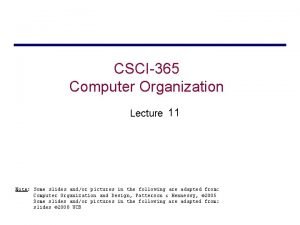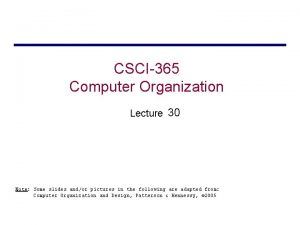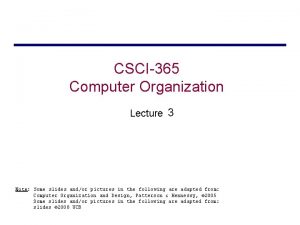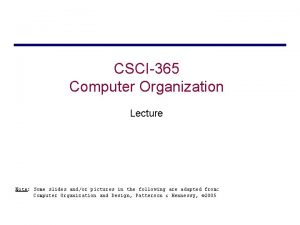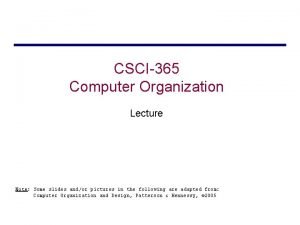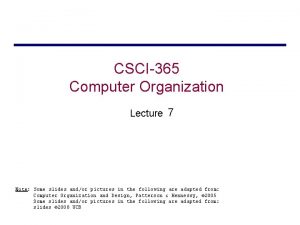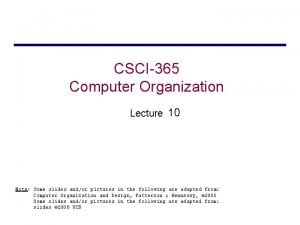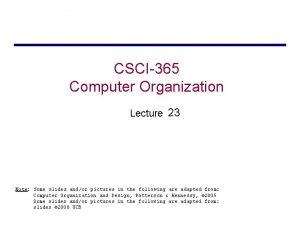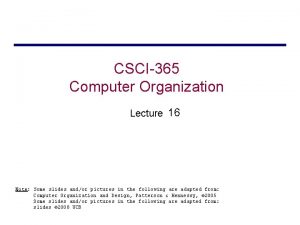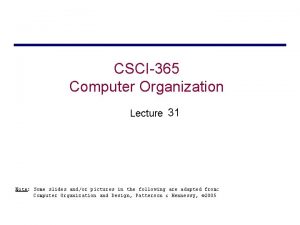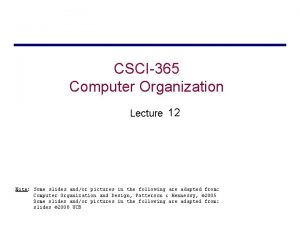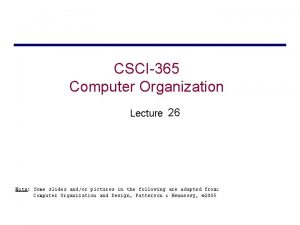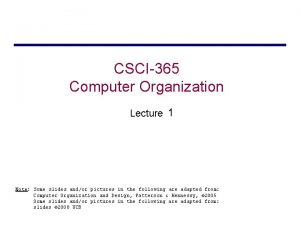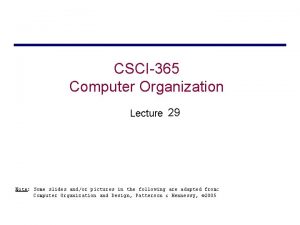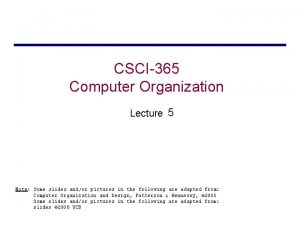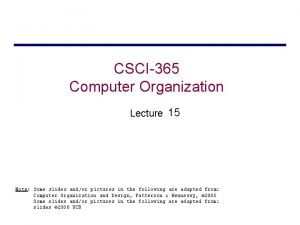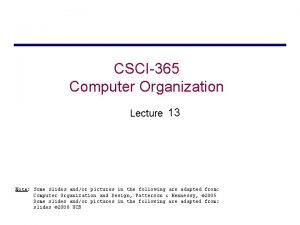CSCI365 Computer Organization Lecture 1 Note Some slides


















- Slides: 18

CSCI-365 Computer Organization Lecture 1 Note: Some slides and/or pictures in the following are adapted from: Computer Organization and Design, Patterson & Hennessy, © 2005 Some slides and/or pictures in the following are adapted from: slides © 2008 UCB

Course Information • Course Website http: //www. stfx. ca/people/igondra/csci 365

Are Computers Smart? • To a programmer: – Very complex operations / functions: • (map (lambda (x) (* x x)) '(1 2 3 4)) – Automatic memory management: • List l = new List; – “Basic” structures: • Integers, floats, characters, plus, minus, print commands Computers are smart!

Are Computers Smart? • In real life at the lowest level: – Only a handful of operations: • {and, or, not} – No automatic memory management – Only 2 values: • {0, 1} or {low, high} or {off, on} Computers are dumb!

What is CSCI-365? Application (ex: browser) Compiler Software Hardware Assembler CSCI-365 Operating System (Mac OSX) Processor Memory I/O system Instruction Set Architecture Datapath & Control Digital Design Circuit Design transistors Coordination of many levels (layers) of abstraction

Instruction Set Architecture • Basic job of a CPU: execute lots of instructions • Instructions are the primitive operations that the CPU may execute • Different CPUs implement different sets of instructions. The set of instructions a particular CPU implements is an Instruction Set Architecture (ISA) – Examples: Intel 80 x 86 (Pentium 4), IBM/Motorola Power. PC (Macintosh), MIPS, Intel IA 64, . . .

Instruction Set Architecture software instruction set hardware

MIPS Architecture • MIPS – semiconductor company that built one of the first commercial RISC architectures • We will study the MIPS architecture in some detail in this class • Why MIPS instead of Intel 80 x 86? – MIPS is simple, elegant. Don’t want to get bogged down in gritty details – MIPS still widely used in embedded applications

CSCI-365 Levels of Representation High Level Language Program (e. g. , C) Compiler Assembly Language Program (e. g. , MIPS) Assembler Machine Language Program (MIPS) Machine Interpretation Hardware Architecture Description (e. g. , block diagrams) Architecture Implementation Logic Circuit Description (Circuit Schematic Diagrams) temp = v[k]; v[k] = v[k+1]; v[k+1] = temp; lw $t 0, 0($2) lw $t 1, 4($2) sw $t 1, 0($2) sw $t 0, 4($2) 0000 1010 1100 0101 1001 1111 0110 1000 1100 0101 1010 0000 0110 1000 1111 1001 1010 0000 0101 1100 1111 1000 0110 0101 1100 0000 1010 1000 0110 1001 1111

Anatomy of a Computer Processor Control (“brain”) Datapath (“brawn”) Memory (where programs, data live when running) Devices Input Output Keyboard, Mouse Disk (where programs, data live when not running) Display, Printer

Integrated Circuits Bare Die • Primarily Crystalline Silicon • 1 mm - 25 mm on a side • 2007 feature size ~ 65 nm = 65 x 10 -9 m (then 45, 32, 22, and 16 [by yr 2013]) • 100 - 1000 M transistors • (25 - 100 M “logic gates”) Chip in Package • Package provides: – spreading of chip-level signal paths to board-level – heat dissipation • Ceramic or plastic with gold wires

Power. PC Die Photograph Let’s look closer…

Transistor Circuit Rep. vs. Block diagram • Chips composed of nothing but transistors and wires • Small groups of transistors form useful building blocks E. g. , NAND gate “ 1” (voltage source) “ 0” (ground) a 0 0 1 1 b 0 1 c 1 1 1 0 • Blocks are organized in a hierarchy to build higher-level blocks: E. g. , adders

Printed Circuit Boards • fiberglass or ceramic • 1 -20 conductive layers • 1 -20 in on a side • IC packages are soldered down • Provides: – Mechanical support – Distribution of power and heat

# of transistors on an IC Technology Trends: Microprocessor Complexity Gordon Moore Intel Cofounder 2 X Transistors / Chip Every 1. 5 years Called “Moore’s Law” Year

Bits Technology Trends: Memory Capacity (Single-Chip DRAM) Year • Now 1. 4 X/yr, or 2 X every 2 years • 8000 X since 1980! year size (Mbit) 1980 0. 0625 1983 0. 25 1986 1 1989 4 1992 16 1996 64 1998 128 2000 256 2002 512 2004 1024 (1 Gbit) 2006 2048 (2 Gbit)

Performance (vs. VAX-11/780) Technology Trends: Uniprocessor Performance (SPECint) 1. 20 x/year 1. 52 x/year 1. 25 x/year • VAX : 1. 25 x/year 1978 to 1986 • RISC + x 86: 1. 52 x/year 1986 to 2002 • RISC + x 86: 1. 20 x/year 2002 to present

Computer Technology – Dramatic Change! • Memory – DRAM capacity: 2 x / 2 years (since ‘ 96); 64 x size improvement in last decade • Processor – Speed 2 x / 1. 5 years (since ‘ 85); [slowing!] 100 X performance in last decade • Disk – Capacity: 2 x / 1 year (since ‘ 97) 250 X size in last decade
 Process organization in computer organization
Process organization in computer organization A small child slides down the four frictionless slides
A small child slides down the four frictionless slides John pushes hector on a plastic toboggan
John pushes hector on a plastic toboggan Principles of economics powerpoint lecture slides
Principles of economics powerpoint lecture slides Introduction to machine learning ethem alpaydın
Introduction to machine learning ethem alpaydın Business communication lecture slides
Business communication lecture slides 01:640:244 lecture notes - lecture 15: plat, idah, farad
01:640:244 lecture notes - lecture 15: plat, idah, farad Lecture note tiu
Lecture note tiu Basic structure of a computer system
Basic structure of a computer system Difference between computer architecture and organization
Difference between computer architecture and organization Complete computer description in computer organization
Complete computer description in computer organization Design of a basic computer
Design of a basic computer Difference between note making and note taking
Difference between note making and note taking Word signal
Word signal Difference between note making and note taking
Difference between note making and note taking Goods received note vs delivery note
Goods received note vs delivery note Draw a specimen of debit note
Draw a specimen of debit note What is a debit memo
What is a debit memo Note taking and note making
Note taking and note making



















